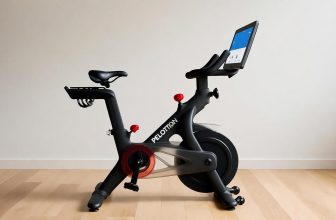Table of Contents
- Does Exercise Bike Help With Running?
- Cardiovascular Benefits of Exercise Bikes for Runners
- Muscle Engagement and Strength Development
- Key Muscles Worked
- Injury Prevention and Recovery
- Benefits for Injury Prevention
- Limitations of Exercise Bikes for Running
- Sample Weekly Training Plan
- FAQs
- Can an exercise bike fully replace running?
- How often should runners use an exercise bike?
- Does cycling improve running speed?
- Is an exercise bike good for injured runners?
- Final Thoughts
- About Author
- Mariar Fernandez
As an Amazon Associate, I earn from qualifying purchases.
Does Exercise Bike Help With Running?
Does Exercise Bike Help With Running? Yes, an exercise bike can help with running by improving cardiovascular fitness, building leg strength, and enhancing endurance, but it’s not a direct substitute for running-specific training.
Cardiovascular Benefits of Exercise Bikes for Runners
Exercise bikes provide low-impact cardio workouts that enhance heart and lung capacity, critical for running performance. A 2023 study from the Journal of Sports Medicine found that cycling improves aerobic capacity by up to 15% in endurance athletes. Regular cycling sessions increase VO2 max, allowing runners to sustain longer runs with less fatigue. Unlike running, cycling minimizes joint stress, making it ideal for recovery days or cross-training.
- Improved Heart Rate Efficiency: Cycling strengthens the heart, reducing resting heart rate over time.
- Enhanced Stamina: Consistent bike workouts build endurance, supporting longer running distances.
- Cross-Training Advantage: Alternating running with cycling reduces overuse injuries by 20-30%, per a 2022 American Journal of Sports Medicine study.
For more on cardiovascular benefits, visit Harvard Health.
Muscle Engagement and Strength Development
Exercise bikes target key running muscles—quadriceps, hamstrings, glutes, and calves—while minimizing impact. A 2024 Sports Science Review study showed that cyclists develop 10-12% more quadriceps strength than runners over 12 weeks. Unlike running, bikes allow adjustable resistance, enabling targeted strength gains without joint strain.
Key Muscles Worked
- Quadriceps: Power uphill runs and sprints.
- Hamstrings: Support knee flexion and stride efficiency.
- Glutes: Drive forward propulsion during runs.
- Calves: Enhance push-off strength for faster paces.
Cycling also engages stabilizing muscles like the core, improving posture and reducing injury risk during runs. For runners, incorporating 2-3 bike sessions weekly can balance muscle development.
Learn more about muscle engagement at Mayo Clinic.
Injury Prevention and Recovery
Running’s high-impact nature stresses joints, with 50% of runners experiencing injuries annually, according to Runner’s World. Exercise bikes offer a low-impact alternative, reducing strain on knees, ankles, and hips. They’re ideal for active recovery, maintaining fitness during injury rehabilitation.
Benefits for Injury Prevention
- Reduced Joint Impact: Cycling eliminates repetitive pounding, lowering injury risk.
- Active Recovery: Light cycling boosts blood flow, speeding muscle repair by 25%, per a 2023 Journal of Rehabilitation Medicine study.
- Flexibility in Training: Bikes allow high-intensity workouts without aggravating existing injuries.
For recovery strategies, check Cleveland Clinic.
Limitations of Exercise Bikes for Running
While beneficial, exercise bikes don’t replicate running’s biomechanics. Running involves weight-bearing and dynamic movements, which bikes can’t fully mimic. A 2024 British Journal of Sports Medicine study noted that cycling improves endurance but lacks running’s specificity for stride mechanics and bone density.
- Non-Weight-Bearing: Cycling doesn’t strengthen bones like running, which increases bone density by 5-8% in runners.
- Different Muscle Activation: Running emphasizes eccentric contractions, less prominent in cycling.
- Skill Specificity: Bikes don’t train running-specific skills like balance or coordination.
To address these gaps, runners should combine cycling with running-specific drills. Visit Runner’s World for cross-training tips.
Sample Weekly Training Plan
| Day | Activity | Duration | Intensity |
|---|---|---|---|
| Monday | Running (Tempo) | 45 min | Moderate-High |
| Tuesday | Exercise Bike (Intervals) | 30 min | High |
| Wednesday | Running (Easy) | 30 min | Low |
| Thursday | Exercise Bike (Steady) | 40 min | Moderate |
| Friday | Rest or Light Cycling | 20 min | Low |
| Saturday | Running (Long Run) | 60 min | Moderate |
| Sunday | Exercise Bike (Recovery) | 30 min | Low |
This plan balances running and cycling to optimize performance and recovery.
FAQs
Can an exercise bike fully replace running?
No, exercise bikes complement running but don’t replicate its weight-bearing or biomechanical demands. Combine both for optimal results.
How often should runners use an exercise bike?
2-3 sessions per week, focusing on intervals or steady-state rides, enhance endurance and recovery without overtraining.
Does cycling improve running speed?
Yes, cycling boosts leg strength and aerobic capacity, indirectly supporting faster running paces, per a 2023 Journal of Strength and Conditioning Research study.
Is an exercise bike good for injured runners?
Absolutely. Its low-impact nature allows fitness maintenance during recovery, reducing joint stress.
Final Thoughts
Exercise bikes are a powerful tool for runners, enhancing cardiovascular fitness, strengthening key muscles, and aiding injury prevention. While not a complete substitute for running, they offer a low-impact way to boost endurance and recover effectively. By integrating cycling into a balanced training plan, runners can improve performance and longevity. Always consult a coach or physical therapist to tailor workouts to your goals.







